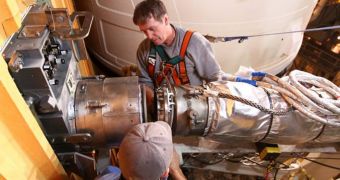Officials at the American space agency announce that they are now planning to launch the space shuttle Discovery on December 3, more than a month after the initial November 1 take-off date. The delays were caused by numerous malfunctions and glitches in the orbiter.
In early November, shuttle technicians discovered a host of problems in the spacecraft's fuel lines and computers, and they eventually decided to delay the launch by more than a month, in order to have ample time for repairs.
Now, as the work is nearing an end, NASA officials are convinced that Discovery will be ready for its final voyage within two weeks. Take-off is now planned for Friday, December 3, at 2:52 am EST (0752 GMT).
However, before this schedule is approved, the shuttle needs to pass a series of safety reviews, where experts will analyze whether the repairs fixed all problems. The STS-133 flight will be cleared only if Discovery passes the tests with flying colors.
The orbiter is scheduled to fly to the International Space Station (ISS), where it will deliver the the Permanent Multipurpose Module (PMM) Leonardo and the third of four ExPRESS Logistics Carriers, alongside Robonaut 2, a humanoid robot developed by NASA and General Motors.
The machine was designed to assist with various tasks on the ISS, and to eventually aid astronauts performing extra-vehicular activities (EVA). If Robonaut 2 is successful, then other robots may soon follow.
Discovery has between November 30 and December 6 to launch to the orbital facility before the window closes. The next available launch window opens in February 2011, but shuttle Endeavor is scheduled to take off at that time.
Theoretically, Endeavor's flight is the last shuttle mission on the NASA flight manifest, but Congress recently passed legislation that may allow for another orbiter flight in June 2011. If the plan is approved, than Atlantis will most likely conduct the STS-135 mission.
As the space shuttles retire, the United States will find itself in a position where it will not be able to access space directly, neither with crews nor cargo. It will therefore have to rely on international partners in order to get to the ISS.
Russia and China will remain the only two countries with the ability to put people in low-Earth orbit (LEO). The European Space Agency and JAXA will also be able to deliver cargo to the space station.
The US will have to wait for a few more years, until private corporations manage to develop their planned systems sufficiently to allow for routine deliveries to LEO. There are several companies in this race, but they are all at least a couple of years away from achieving their goals.
In the mean time, NASA will cooperate with ESA, JAXA and RosCosmos in securing seats for its astronauts, as well as room for the supplies it wants to send to astronauts in orbit. Crews will arrive on the ISS aboard Russian Soyuz space capsules, Space reports.

 14 DAY TRIAL //
14 DAY TRIAL //